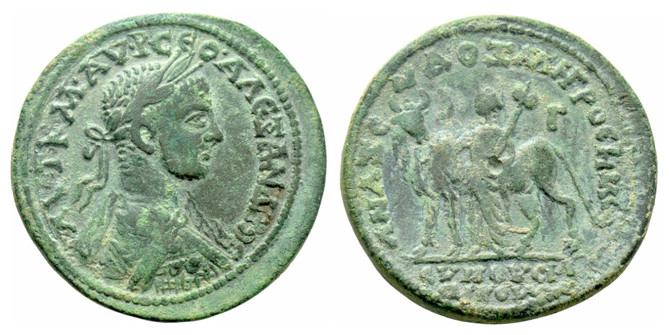| 221 AD - 235
AD |
Anazarbus Cilicia Severus Alexander
Ανάζαρβος Κιλικία Σεουήρος Αλεξανδρος
| AE 35 |
SHH 7112 |
 |
| Parameter Obverse Reverse Notes Reference Provenance Parameter |
24.91 g 34.9-36.0 mm 2.9 eqmm
7:00
o'clock VF centering - / + σmax(SigmaTest, 240 kHz) = obv. 7.2, rev. 7.2 MS/m Laureate draped and cuirassed bust of Severus Alexander right; AVT K M A CE AΛEΞANΔPOC clockwise around; border of dots. Synthysia standing left, wearing modius and holding double-axe; in the background, ox left looking back; ANAZ ENΔOΞ MHTPO ET HMC clockwise around, CVNΘVCIA // OIKOVM in exergue; in upper field, B to left, Γ to right; border of dots. ? RPC VI 7338 temporary Ex Numismatik Naumann 88/517, 5.4.2020 Electrical Conductivity σ [MS/m]. Sigmatest, coin center (0;0)
|
|
The female
figure standing before the bull and holding the bipennis (double-headed
axe) has been referred to as the personification of the Synthysia. The
Synthysia was a joint sacrificial feast held by the city hosting the
festive games. The feast would be attended by representatives from the
participating cities, and given the imagery on this coin, it is likely
that the proceedings involved, amongst other things, a whole lotta cow
dismemberment. The meat from these sacrifices may also have been part
of the prize awarded to winners of the games. I guess nothing says
athletic gold like a bloody hunk of beef.
These festivals and games appear to have been particularly important in the eastern provinces, and their coinage with agonistic designs appear with some frequency. In 3rd century issues from Cilician cities such as Tarsus and Anazarbus, we find quite a variety - those depicting the crown of the demiourgos (who organized the games), the gymnasiarch (who officiated), competing athletes, agonistic urns (or prize crowns as they are sometimes called) and others. [https://www.cointalk.com/threads/ancients-the-non-secular-games.244376/] |